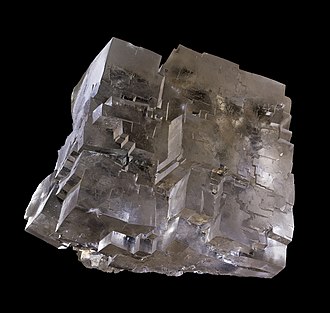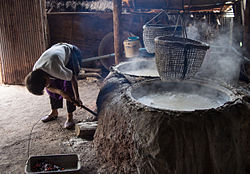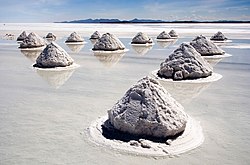Salt
In chemistry, a salt is any neutral chemical compound made of cations (positive ions) attached to anions (negative ions). The most common example of a salt is sodium chloride, with the chemical formula NaCl - this is the table salt that people use in food.
Classically, salts are the result of a reaction between an acid and a base.[1] Sodium chloride, for example, is the product when hydrochloric acid reacts with sodium hydroxide:
- HCl + NaOH → NaCl + H
2O
Mixtures of salts in water are called electrolytes. Electricity is able to pass through electrolytes, as well as molten salts.
Salts can melt ice, because salts lower the temperature needed for liquid to freeze.[2] Because of that, streets are sometimes treated with salt in winter, if the temperature is only a little below freezing.[3]
A salt can also be explained as an ionic compound which dissociates, forming a positive ion other than hydrogen ion, and a negative ion other than hydroxide ion.[4]
History
Because many germs cannot live in salt, it has been used to preserve food. Its use as a food preservative helped large amounts of food to be stored, sent a long way, and eaten all through the year. This helped populations to grow, cities to develop, and soldiers in wars to be fed. Salt was probably used in Egypt as long ago as 4000 BC. In ancient times, salt was more valuable than it is now, because it was hard to get in many places, and could be used not only to give foods flavour, but also to make them last longer. It allowed food to be kept past its season, and taken on long trips.
People often traded salt for other things. It was of high value in China, Turkey, the Middle East, and Africa. In the Mediterranean area, including Ancient Rome, salt was even used for money. The word salary comes from the Latin word for salt, because they paid people in salt. After people learned how to get salt from the ocean, salt became cheaper. The Phoenicians were some of the first to figure out how to do this, by pouring seawater on dry land. Then when it dried, they collected the salt and sold it.
Another use of salt was in war, as a way to punish a city by ruining its crops. This is called "salting the Earth". The Assyrians are said to have been one of the first to have done this to their neighbours.
Looks
Colour
Salts can be found in all different colours: yellow (sodium chromate), orange (potassium dichromate), red (mercury sulphide), mauve (cobalt chloride hexahydrate), blue (copper sulfate pentahydrate, ferric hexacyanoferrate), green (nickel oxide), colorless (magnesium sulphate), white (titanium dioxide), and black (manganese dioxide). Most minerals and inorganic pigments, as well as many synthetic organic dyes, are salts.
Salt Media
Salt production in Halle, Saxony-Anhalt, 1670
Ponds near Maras, Peru, fed from a mineral spring and used for salt production since pre-Inca times
A SEM image of a grain of table salt
Comparison of table salt with kitchen salt. Shows a typical salt shaker and salt bowl with salt spread before each on a black background.
The Sifto Canada salt mine and processing plant at the harbor in Goderich, Ontario, Canada
Bread and salt at a Russian wedding ceremony
Brine from salt wells is boiled to produce salt at Nan Province, Thailand
Salt mounds in Salar de Uyuni, Bolivia
Sea-salt pans in Tamil Nadu, India
References
- ↑ Kavanah, Patrick (2018). Chemistry: The Physical Setting. Pearson. ISBN 978-0-328-98858-7.
- ↑ "Salt Lowers Freezing Point of Water – David Bradley". www.sciencebase.com.
- ↑ "Salt treatment for icy streets". 12 March 2016. Archived from the original on 2016-03-12.
- ↑ Kavanah, Patrick (2018). Chemistry: The Physical Setting. Pearson. ISBN 978-0-328-98858-7.








